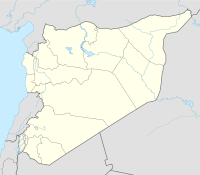Apamea (Syria)
| Greek: Ἀπάμεια Arabic: آفاميا |
|

View of Apamea ruins
|
|
| Location | Hama Governorate, Syria |
|---|---|
| Region | Ghab plain |
| Coordinates | 35°25′05″N 36°23′53″E / 35.418°N 36.398°E |
| Type | settlement |
| History | |
| Builder | Seleucus I Nicator |
| Founded | ca. 300 BC |
| Abandoned | 13th century |
| Cultures | Seleucid, Roman, Byzantine, Arab |
| Site notes | |
| Condition | ruins |
| Ownership | Public |
| Public access | Yes |
Apamea (Greek: Ἀπάμεια, Apameia; Arabic: آفاميا, Afamia), on the right bank of the Orontes River, was an ancient Greek and Roman city. It was the capital of Apamene under the Macedonians, became the capital and metropolitan archbishopric of late Roman province Syria Secunda and later a multiple Catholic titular see.
Amongst the impressive ancient remains, the site includes the Great Colonnade which ran for nearly 2 km (1.2 mi) making it among the longest in the Roman world and the Roman Theatre, one of the largest surviving theatres of the Roman Empire with an estimated seating capacity in excess of 20,000.
The site is about 55 km (34 mi) to the northwest of Hama, Syria, overlooking the Ghab valley.
After the conquest of the region by Alexander the Great and the subsequent wars between his generals, Apamea fell under the command of the former Macedonian general Seleucus from about 312 BC. From about 300 BC Apamea was fortified and established as a city by Seleucus who named it after his Bactrian wife, Apama daughter of the Sogdian warlord Spitamenes (not his mother, as Stephanus asserts; compare Strabo, p. 578). The site was enclosed in a loop of the Orontes which, with the lake and marshes, gave it a peninsular form whence its other name of Cherronêsos. It was located at a strategic crossroads for Eastern commerce and became one of the four cities of the Syrian tetrapolis. Seleucus also made it a military base with 500 elephants, and an equestrian stud with 30,000 mares and 300 stallions.
...
Wikipedia

